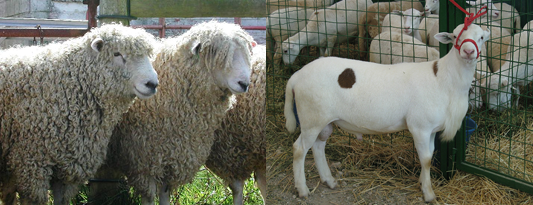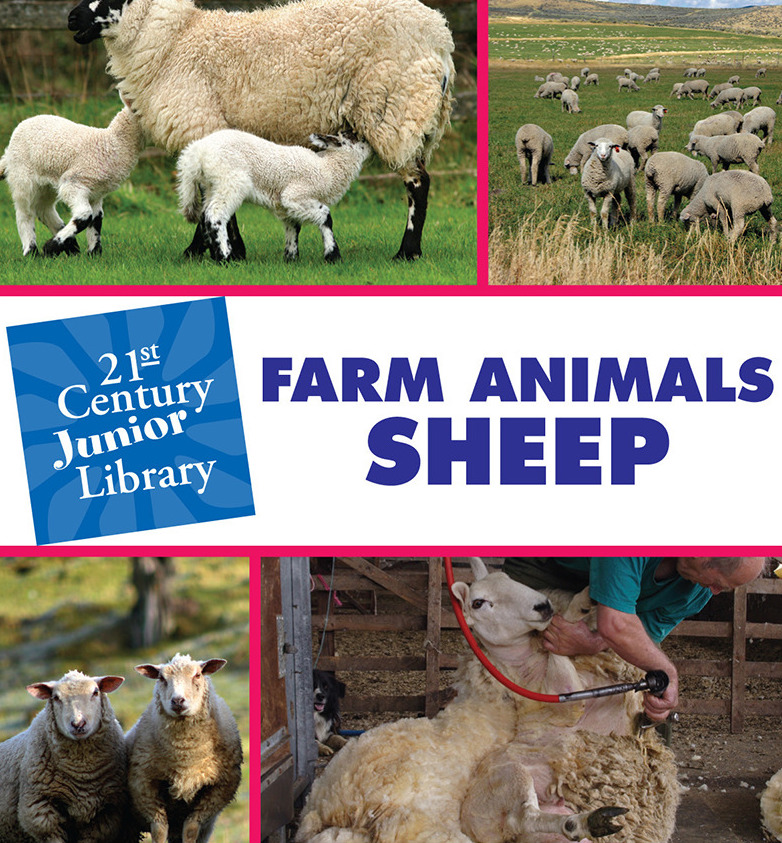Agricultural Literacy Curriculum Matrix
Lesson Plan
A Tail of Two Sheep
Grade Level
Purpose
Students compare and contrast hair sheep and wool sheep, discover the reasons why farmers raise sheep, and explore ways farmers meet the needs of the sheep they raise. Grades K-2
Estimated Time
Materials Needed
Engage:
- Wool Sheep image
- Hair Sheep image
- Venn diagram
Activity:
- Farm Animals: Sheep by Cecilia Minden
- Agriculture Graphic Organizer Sheep Retell page
Vocabulary
breed: a group of animals or plants within a species having a distinctive appearance and typically having been developed by deliberate selection
parasite: an animal or plant that lives in or on another animal or plant in order to get food and protection
shear: cut the wool off
wool: the fine, soft, curly or wavy hair forming the coat of a sheep, goat, or similar animal used in making cloth or yarn
Did You Know?
- Meat from a sheep that is less than 1 year old is called lamb.
- Meat from a sheep that is 1 year or older is called mutton.
- Sheep are produced in all 50 states.
- Ewes usually give birth to 1-3 lambs.
Background Agricultural Connections
There are different types or breeds of sheep. Some sheep, such as Dorset, are wool sheep raised for their wool, meat, and/or milk. Wool sheep grow thick wool that needs to be sheared because they do not naturally shed. The wool fiber is used to make yarn, fabric, carpets, and upholstery. Some sheep, such as Katahdin, are hair sheep. They mainly grow hair that sheds naturally and do not need to be sheared. Hair sheep are raised for their meat and milk. Their hair is not suitable for spinning or felting.
The hair sheep breeds make up a little more than 10% of the world's sheep population.1 Hair sheep have a resistance to internal parasites, are fairly tolerant to heat, are good breeders, and forage on weeds and plants that wool sheep and cattle avoid. Hair sheep are not suitable for competitive market lamb shows because they are smaller than most wool sheep and do not produce as much meat per ewe.2 Many view hair sheep to be less attractive than wool sheep. Bred for hot, humid climates, hair sheep tend to not do as well in cold weather as wool sheep.
A common misconception is that hair sheep are a cross between breeds of goats and sheep. This is not true. The primary difference between hair and wool sheep is the ratio of hair to wool fibers. Although both have some hair and wool, hair sheep have more hair and wool sheep have more wool fibers.
Engage
- Show the students pictures of a wool sheep and a hair sheep.

- Ask the students to compare and contrast the wool sheep and the hair sheep. Use a Venn diagram to list the similarities and differences. You may need to guide the students to look closely at the coat of the sheep.
- Explain to the students that they will explore the differences between wool sheep and hair sheep.
Explore and Explain
 Read Farm Animals: Sheep by Cecilia Minden.
Read Farm Animals: Sheep by Cecilia Minden.- Refer back to the Venn diagram and the two sheep pictures from the Engage section of this lesson. Lead a class discussion about wool and hair sheep. Include the following points in the discussion:
- Most sheep have wool that needs to be sheared or cut off to keep the sheep cool. They are called wool sheep.
- Some sheep have hair, which does not need to be sheared because the sheep shed naturally. They are called hair sheep.
- Some farmers choose to raise hair sheep because they do not need to be sheared.
- Ask the students, "What can wool sheep provide for us?" (wool for clothes, meat, and sheep milk for cheese) "What can hair sheep provide for us?" (meat and sheep milk for cheese) Explain to the students that hair sheep's hair sheds just like a dog sheds its hair. The hair is not used for yarn or fabric because it is different than wool fibers.
- Allow time for the students to make changes or additions to their Venn diagram using the information from the book or class discussion.
- Ask the students, "What do sheep need to survive?" (food, water, shelter, and air just like humans) Add this information to the Venn diagram. Explain to the students that wool sheep and hair sheep both have the same needs. Sheep eat grass, hay, and grains.
- Have the students use the Agriculture Graphic Organizer Sheep Retell page to tell or write what they learned about wool sheep and hair sheep.
Elaborate
-
Have the students research different breeds of wool and hair sheep.
-
Have the students research different uses for wool, such as clothes, fabrics, carpets, etc.
-
Bring wool into the classroom for student observation. A Wool Sample Kit is available for purchase from agclassroomstore.com.
-
Use the instructions from the Hands-on With Wool activity to have the students dye wool and/or felt wool into marbles or fabric.
-
View the How Wool is Made into Fabric video to learn more about raising sheep, shearing, and milling wool.
Evaluate
After conducting these activities, review and summarize the following key concepts:
- There are different breeds of sheep that are raised for their wool, meat, and/or milk.
- Wool sheep grow thick wool that needs to be sheared because they do not naturally shed.
- Hair sheep grow hair that sheds naturally and do not need to be sheared.
- Wool sheep and hair sheep both have some wool and some hair. Wool sheep have more wool fibers and hair sheep have more hair.
Sources
- http://afs.okstate.edu/breeds/sheep/hair.html/
- https://www.uapb.edu/sites/www/Uploads/SAFHS/FSA-9616.pdf
Recommended Companion Resources
- A New Coat for Anna
- A Young Shepherd
- About...Books
- Brave Dogs, Gentle Dogs
- Charlie Needs a Cloak
- Ewe Bee Ewe: A Sheep Tail
- Farm Animals: Sheep
- From Sheep to Sweater
- Hands-On With Wool
- Homespun Sarah
- If You Want to Knit Some Mittens
- Sheep 101
- Sheep on the Farm
- Sheepology: The Ultimate Encyclopedia
- The Perfect Barn
- The Surprise
- Warm as Wool
- Weaving the Rainbow
- Where Did My Clothes Come From?
- Wild Rose's Weaving
- Wool Ewe Keep Me Warm? Video
- Wool Samples
- Wool Spinning Kit
Author
Organization
| We welcome your feedback! If you have a question about this lesson or would like to report a broken link, please send us an email. If you have used this lesson and are willing to share your experience, we will provide you with a coupon code for 10% off your next purchase at AgClassroomStore. |
